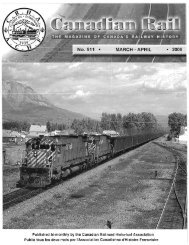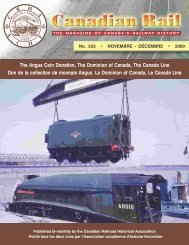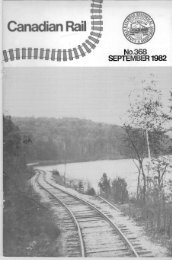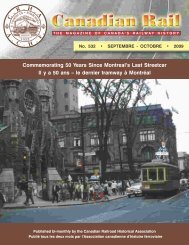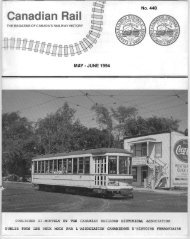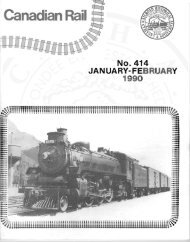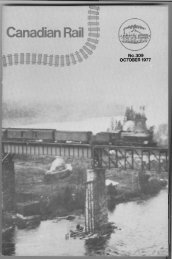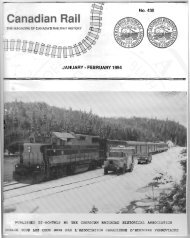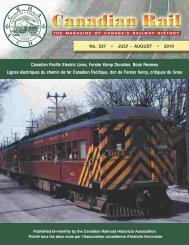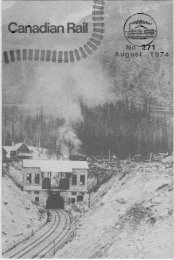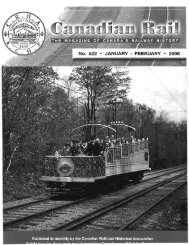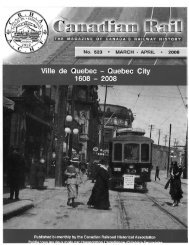Canadian Rail_no538_2010 - Le musée ferroviaire canadien
Canadian Rail_no538_2010 - Le musée ferroviaire canadien
Canadian Rail_no538_2010 - Le musée ferroviaire canadien
Create successful ePaper yourself
Turn your PDF publications into a flip-book with our unique Google optimized e-Paper software.
SEPTEMBER – OCTOBER <strong>2010</strong><br />
229 CANADIAN RAIL • 538<br />
after making nine stops, arrived in Montreal at 0750.<br />
Returning train 55 departed at 1830 and reached St.<br />
Jerome at 2000. For many years the commuter trains<br />
terminated in the eastern part of the city - first at the<br />
Dalhousie Square and, after 1898, at the Place Viger<br />
Station. At that time the business district of the city along<br />
Craig (now St. Antoine and Nortre Dame Streets) was<br />
only a short walk or tram ride eastward.<br />
While the Place Viger Station was a very busy<br />
terminal at times, this came primarily from the intercity<br />
traffic to distant points like Ottawa, the Laurentians and<br />
Quebec City. By 1928, there were seventeen scheduled<br />
weekday arrivals and departures. Only three of these were<br />
commuter trains.<br />
When Place Viger Station closed in May 1951,<br />
there were only seven weekday arrivals and departures, of<br />
which two inbound and three outbound operated at<br />
commuter hours. These trains were transferred to<br />
Windsor Station. Commuter traffic fell sharply when the<br />
southern sections of the Laurentian Autoroute opened in<br />
the late 1950s. The last commuter train, indeed the last<br />
passenger train service of any kind, operated to Ste.<br />
Therese until it was terminated on October 1, 1982.<br />
Pendant plusieurs années, ces trains terminèrent<br />
leur parcours dans le secteur est de la ville à proximité de<br />
la gare Place Viger. Il y avait des départs fréquents entre<br />
Sainte-Thérèse et Montréal avec correspondance vers<br />
Saint-Eustache. Une courte distance en tramway<br />
séparait d’ailleurs la gare Place Viger du quartier des<br />
affaires situé le long des rues Craig (maintenant Saint-<br />
Antoine) et Notre-Dame.<br />
Après la fermeture de la gare Place Viger en mai<br />
1951, le service de trains de banlieue fut déplacé vers la<br />
gare Windsor jusqu’au 1er octobre 1982. C’est à ce<br />
moment que le gouvernement du Québec prit en charge<br />
les trains de banlieue du CPR et que, malheureusement,<br />
le service vers Sainte-Thérèse fut aboli.<br />
On Sunday, November 6, 1960, the CRHA operated what would be the last CPR steam excursion. Number 29, one of the Norton –<br />
Chipman famous trio of 4-4-0s hauled a combine and two coaches to St. Lin, Quebec, to commemorate the 75th. anniversary of<br />
the driving of the last spike on the CPR. In this shot, taken at Ste. Therese, of 29 watering, we also see the Ste. Therese<br />
heavyweight commuter train laying over in the background. R. S. Ritchie.<br />
<strong>Le</strong> dimanche 6 novembre 1960, l’ACHF organisa ce qui devait être la dernière excursion en train vapeur, soulignant le 75e<br />
anniversaire de la pose du dernier crampon du premier transcontinental <strong>canadien</strong>. La no 29, l’une des fameuses 4-4-0 de Norton-<br />
Chipman, était à la tête d’une voiture combinée et de deux voitures coach pour un parcours sur la ligne du CPR vers Saint-Lin au<br />
Québec. On aperçoit sur ce cliché, pris à Sainte-Thérèse, la no 29 s’approvisionnant en eau, et en arrière-plan, le train de banlieue<br />
de Sainte-Thérèse. R.S. Ritchie.



